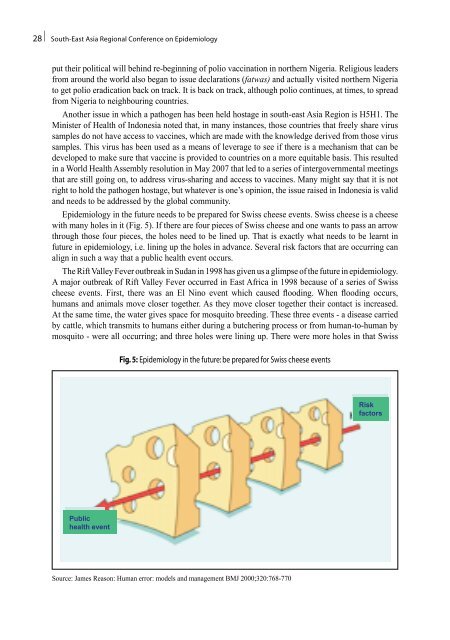South-East Asia Regional Conference on Epidemiology
South-East Asia Regional Conference on Epidemiology
South-East Asia Regional Conference on Epidemiology
Create successful ePaper yourself
Turn your PDF publications into a flip-book with our unique Google optimized e-Paper software.
28 | <str<strong>on</strong>g>South</str<strong>on</strong>g>-<str<strong>on</strong>g>East</str<strong>on</strong>g> <str<strong>on</strong>g>Asia</str<strong>on</strong>g> <str<strong>on</strong>g>Regi<strong>on</strong>al</str<strong>on</strong>g> <str<strong>on</strong>g>C<strong>on</strong>ference</str<strong>on</strong>g> <strong>on</strong> <strong>Epidemiology</strong><br />
put their political will behind re-beginning of polio vaccinati<strong>on</strong> in northern Nigeria. Religious leaders<br />
from around the world also began to issue declarati<strong>on</strong>s (fatwas) and actually visited northern Nigeria<br />
to get polio eradicati<strong>on</strong> back <strong>on</strong> track. It is back <strong>on</strong> track, although polio c<strong>on</strong>tinues, at times, to spread<br />
from Nigeria to neighbouring countries.<br />
Another issue in which a pathogen has been held hostage in south-east <str<strong>on</strong>g>Asia</str<strong>on</strong>g> Regi<strong>on</strong> is H5H1. The<br />
Minister of Health of Ind<strong>on</strong>esia noted that, in many instances, those countries that freely share virus<br />
samples do not have access to vaccines, which are made with the knowledge derived from those virus<br />
samples. This virus has been used as a means of leverage to see if there is a mechanism that can be<br />
developed to make sure that vaccine is provided to countries <strong>on</strong> a more equitable basis. This resulted<br />
in a World Health Assembly resoluti<strong>on</strong> in May 2007 that led to a series of intergovernmental meetings<br />
that are still going <strong>on</strong>, to address virus-sharing and access to vaccines. Many might say that it is not<br />
right to hold the pathogen hostage, but whatever is <strong>on</strong>e’s opini<strong>on</strong>, the issue raised in Ind<strong>on</strong>esia is valid<br />
and needs to be addressed by the global community.<br />
<strong>Epidemiology</strong> in the future needs to be prepared for Swiss cheese events. Swiss cheese is a cheese<br />
with many holes in it (Fig. 5). If there are four pieces of Swiss cheese and <strong>on</strong>e wants to pass an arrow<br />
through those four pieces, the holes need to be lined up. That is exactly what needs to be learnt in<br />
future in epidemiology, i.e. lining up the holes in advance. Several risk factors that are occurring can<br />
align in such a way that a public health event occurs.<br />
The Rift Valley Fever outbreak in Sudan in 1998 has given us a glimpse of the future in epidemiology.<br />
A major outbreak of Rift Valley Fever occurred in <str<strong>on</strong>g>East</str<strong>on</strong>g> Africa in 1998 because of a series of Swiss<br />
cheese events. First, there was an El Nino event which caused flooding. When flooding occurs,<br />
humans and animals move closer together. As they move closer together their c<strong>on</strong>tact is increased.<br />
At the same time, the water gives space for mosquito breeding. These three events - a disease carried<br />
by cattle, which transmits to humans either during a butchering process or from human-to-human by<br />
mosquito - were all occurring; and three holes were lining up. There were more holes in that Swiss<br />
Fig. 5: <strong>Epidemiology</strong> in the future: be prepared for Swiss cheese events<br />
Source: James Reas<strong>on</strong>: Human error: models and management BMJ 2000;320:768-770









